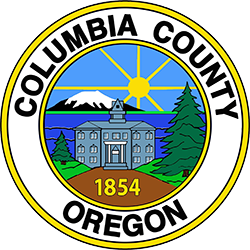How Do We Pay For Roads?
The Road Division of Columbia County’s Public Works department pays for road work from funds received from a number of sources. This includes Oregon’s state-wide gas tax, vehicle registration fees, truck weight mile taxes, aggregate fees, and funds from the federal government in the form of grants distributed by the state. Very little, if any, county property taxes go directly towards repairing county roads unless specifically directed by the Board of Commissioners.
By law, all money received from the state and federal governments is to be used for the maintenance and upkeep of our road system and must be spent within the Road Division.
The majority of the county’s road funds (over 80 percent) come from the state gas tax and vehicle registration fees. The state gas tax comes from a statewide pool which is divided between the state, county, and city agencies, as well as metropolitan planning organizations such as Metro. Counties receive funds based on a formula that accounts for the number of registered vehicles within the county, county road mileage, population, and gas tax receipts as reported by gas stations.
Year to year, the Road Division’s revenue and expenses do not always match, because some money is saved for emergencies and some is carried over and combined with the following year’s revenue for larger, costlier projects.
Typical county road conditions
- In an ideal world, every road would be paved and would be at least 20 feet wide with three-foot shoulders. Unfortunately, funding is limited and pavement is very expensive. For exampls, a 2" asphalt overlay can range anywhere from $250,000 to $300,000 per mile depending on the width of the road and cost of the asphalt (2022 - $175/ton).
- Making a gravel road into a paved road is not as simple as just laying asphalt. The quality of the ground underneath the pavement is just as important as the quality of asphalt. The prep work required can vary, but can easily add $250,000 to the cost per mile to address base rock, vegetation, drainage, and shoulders.
- Some paved roads are in such bad shape that they require a total reconstruction involving excavating the old pavement, rebuilding the rock base, addressing drainage and bringing the road up to current standards as much as feasible. This can easily cost $1 million per mile or more depending on the conditions.
- Pavement doesn’t last forever. Without routine maintenance, asphalt will break down, making it unusable and damaging to the road base. Unfortunately, we find many of the County's paved roads falling into this condition. This is worsened because many were constructed as gravel roads years ago, and the base was not prepared for a chip seal or asphalt surface.
- It’s always a tough decision on what roads to pave with the limited funds we have. The reality of the situation is that the money necessary to maintain even our most important paved roads just doesn’t exist. The most heavily traveled through-routes that have an economic impact on the County are usually first on the list to receive additional pavement. Other factors to consider are safety, drivability, and cost to maintain.
- Just to install a pavement overlay on our current paved roads, on a routine basis, would take an expenditure of about $2.9 million per year. Currently we budget around $600,000 to $800,000 per year for pavement preservation and that covers only about 3 or 4 miles of our 371 paved road miles. Every year that goes by, the cost of fixing our roads increases and changes the maintenance strategy from preservation to more expensive reconstruction efforts.

